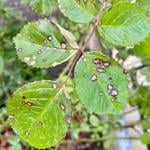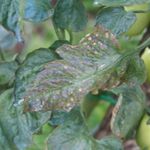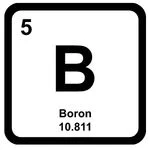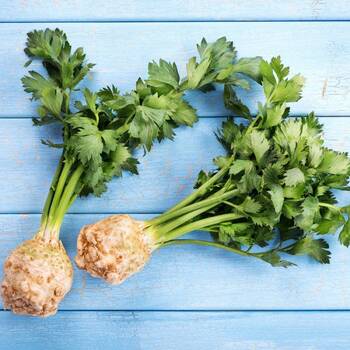
How to Grow Celeriac Seeds
Grow Guide #2482
Family: Apiaceae
Binomial name: Apium graveolens var. rapaceum
Life Cycle: Biennial (usually grown as an annual)
This 'How to Grow' guide details everything a home gardener needs to know to plant, grow and care for Celeriac (Apium graveolens var. rapaceum).
When to Sow Celeriac Seeds
Celeriac is a warm season crop. Use the table below to identify the best time of year to sow celeriac seeds in your climate.
| JAN | FEB | MAR | APR | MAY | JUN | JUL | AUG | SEP | OCT | NOV | DEC | |
|---|---|---|---|---|---|---|---|---|---|---|---|---|
| Cool | ||||||||||||
| Temperate | ||||||||||||
| Sub-Tropical | ||||||||||||
| Tropical | ||||||||||||
| Arid |
Preparation
Celeriac plants are best grown in part shade. Choose a location that will receive between 3 and 6 hours of full sun each day.
Celeriac plants need a well drained soil enriched with plenty of organic matter. Prepare soil by weeding it thoroughly, digging it over to loosen it and adding aged animal manure or compost. Keep the area free of weeds until planting. Learn more about preparing soil for planting here.
Celeriac plants can be grown in containers. If possible choose a variety that’s recommended for container growing. Use a good quality potting mix and make sure your container is large enough for mature plants; a minimum of 20 litres is recommended for celeriac. During the growing season, keep in mind that container grown plants may need additional fertiliser to encourage healthy growth.
How to Sow Celeriac Seeds
Celeriac seeds do not require any treatment (eg soaking, stratification) before sowing.
Celeriac seeds grow best when they are raised in trays or other containers and transplanted to the garden once established.
- Fill trays, punnets or jiffy pots with a good quality seed-raising mix, or use soil starter pellets.
- Sow seeds 5mm deep.
- Keep soil moist but never wet or dry.
- Seeds should germinate in around 14-21 days at a soil temperature of 20-24°C.
- Transplant seedlings to the garden once they have their first true leaves and are large enough to handle (usually 5-10cm tall).
- Plant out, spacing plants 30cm apart, with rows 80cm apart.
Celeriac may bolt if seedlings are exposed to cool weather. Do not transplant seedlings or sow seeds outside in very cool temperatures.
Tip: Celeriac seeds are quite small. Handle them carefully to avoid them blowing away or being washed away. Mix seeds with sand or fine potting mix prior to sowing or use a seed dispenser, damp toothpick or tweezers to help space them evenly. Press lightly into the surface after sowing so that the seeds make good contact with the soil. Take extra care to make sure seeds and seedlings don’t dry out. Read more about sowing small seeds here.
How to Grow Celeriac
Celeriac plants need regular watering during the growing season. Do not let soil dry out; keep soil evenly moist but not waterlogged. Water deeply in the early morning or late afternoon. Avoid watering the leaves of plants to avoid fungal diseases. Learn more about watering here.
If soil was well prepared no extra fertiliser should be necessary. In poor soil or to give your plants an extra boost, application of a balanced fertiliser or one formulated for fruit and vegetables can be beneficial:
- Apply slow release fertiliser at the recommended rate when transplanting or when seedlings are 5-10cm tall.
- Apply liquid fertiliser at the recommended rate and frequency while plants are fruiting or flowering.
How to Harvest Celeriac
Celeriac should be ready to harvest in approximately 120 days.
Celeriac bulbs are ready to harvest when they are large enough to eat, and can be harvested as needed. Harvest individual bulbs by gently pulling at the base of the leaves, or use a garden fork to lift multiple plants from the soil. Shake off any excess dirt and cut the foliage 1-2cm above the top of the bulb. Store celeriac short term in a cool, dark place such as a cupboard. For longer term storage celeriac can be pickled or peeled, blanched and frozen.
Common Problems when Growing Celeriac
Like all plants, celeriac is susceptible to some pests, diseases and other problems. Below is a list of the most common problems gardeners encounter when growing celeriac plants:
 Bacterial leaf spot is a disease that causes irregularly shaped brown spots on all above-ground parts of a plant. The spots at first appear to be wet but become dry and scab-like over time. Leaves and flowers can fall prematurely. Water plants at soil level (not on the leaves), dispose of fallen leaves and fruit and practice crop rotation.
Bacterial leaf spot is a disease that causes irregularly shaped brown spots on all above-ground parts of a plant. The spots at first appear to be wet but become dry and scab-like over time. Leaves and flowers can fall prematurely. Water plants at soil level (not on the leaves), dispose of fallen leaves and fruit and practice crop rotation. Bulbs not forming can be a result of sowing seed at the wrong time of year, growing in hot conditions, inconsistent watering or harvesting too early. Ensure soil is enriched with compost or aged manure prior to planting, plant seeds at the recommended time of year, and keep the soil evenly moist but not waterlogged. Avoid harvesting early; celeriac forms bulbs quickly at the end of the growing period.
Bulbs not forming can be a result of sowing seed at the wrong time of year, growing in hot conditions, inconsistent watering or harvesting too early. Ensure soil is enriched with compost or aged manure prior to planting, plant seeds at the recommended time of year, and keep the soil evenly moist but not waterlogged. Avoid harvesting early; celeriac forms bulbs quickly at the end of the growing period. Bolting is when a plant prematurely flowers and goes to seed. Bolting can be caused by a period of extreme weather. Avoid sowing seed until after the danger of frosts has passed or in very hot weather. Water plants regularly and deeply in hot weather to prevent them suffering heat stress.
Bolting is when a plant prematurely flowers and goes to seed. Bolting can be caused by a period of extreme weather. Avoid sowing seed until after the danger of frosts has passed or in very hot weather. Water plants regularly and deeply in hot weather to prevent them suffering heat stress. Grey mould (Botrytis sp.) is a fungal disease that causes flowers to become mouldy and fruit to rot. Spores are transported by wind and can survive in soil or on green waste. The fungus spreads most in cool, damp weather. Prune off affected flowers and fruit, water plants at soil level (not on leaves) and if necessary spray with an appropriate fungicide or homemade spray.
Grey mould (Botrytis sp.) is a fungal disease that causes flowers to become mouldy and fruit to rot. Spores are transported by wind and can survive in soil or on green waste. The fungus spreads most in cool, damp weather. Prune off affected flowers and fruit, water plants at soil level (not on leaves) and if necessary spray with an appropriate fungicide or homemade spray. Downy mildew is a fungal disease that causes yellow to grey-brown patches on leaves, especially the undersides. Water plants at soil level (not on the leaves), remove and destroy affected leaves and do not overcrowd plants to ensure adequate air flow. If problems persist, spray with a homemade milk spray or fungicide.
Downy mildew is a fungal disease that causes yellow to grey-brown patches on leaves, especially the undersides. Water plants at soil level (not on the leaves), remove and destroy affected leaves and do not overcrowd plants to ensure adequate air flow. If problems persist, spray with a homemade milk spray or fungicide. Slugs and snails are molluscs that feed on tender leaves and shoots, mostly at night, leaving slimy trails behind them. Control them by removing their hiding places, keeping free range poultry, collecting them by torchlight or by placing traps. Read more about slugs and snails here.
Slugs and snails are molluscs that feed on tender leaves and shoots, mostly at night, leaving slimy trails behind them. Control them by removing their hiding places, keeping free range poultry, collecting them by torchlight or by placing traps. Read more about slugs and snails here. Boron deficiency causes yellow leaf tips, hollow discoloured stems or soft brown centres in the roots. Dissolve 1 tablespoon of household boron in 5 litres of water in a watering can and apply when seedlings are 5-10cm tall. Do not use as a general fertiliser as boron is toxic to some plants.
Boron deficiency causes yellow leaf tips, hollow discoloured stems or soft brown centres in the roots. Dissolve 1 tablespoon of household boron in 5 litres of water in a watering can and apply when seedlings are 5-10cm tall. Do not use as a general fertiliser as boron is toxic to some plants.


.png)



